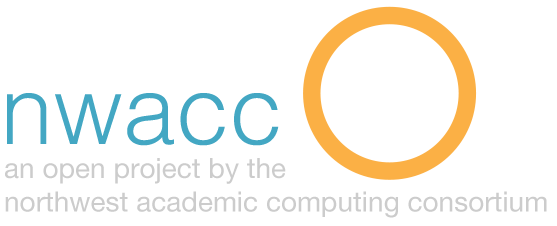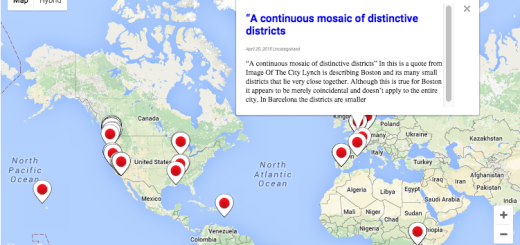NWACCo and EdCampPDX – 2012
This past week I attended two very different, but very well-done and fulfilling Ed-Tech conferences. The first was the Northwest Academic Computing Consortium’s Instructional Technology Roundtable conference. This group is a collection of higher-education institutions that brings together a relatively small group of Instructional Technology folks once a year to talk about issues, strategies, technologies, philosophy and other things for three days in Portland, Oregon. This is the third time I have attended this particular conference and it did not disappoint. I met some fine people that I only see once a year though, and will certainly make a more concerted effort to keep up and follow the fine work that they are doing.
One of the gems of this year’s conference was the “Three Minutes of Fame” session in which individuals had three minutes to come up and share something that they were particularly proud of. It could be something that either they tried out this past year or something that their institution was doing or practicing. There was a time-keeper that made sure the speakers did not go over the allotted three minutes as well! The one that really caught me was something being developed at the University of Washington, called, “SpaceScout.” It’s a web and mobile app that helps students find places to study on and around campus. Very intuitive and potentially very helpful. The plan is to open-source it so that other institutions can add their own data so that their students can access this tool.
Another session that I attended was the Faculty Developoment and Change. The session notes are here. In this session we addressed common issues around helping faculty develop technology skills and the appropriate integration of technology into their work. Of course one of the big issues is how to get faculty to participate in workshops and trainings along with having conversations with faculty around these issues. Starting the conversations is key, in my opinion. Often asking faculty to reflect on something that they are doing or even asking them their backup strategy/plan can jump start a positive conversation. Another question that came up in this session is how do we get faculty to simply talk about the process or the reasoning/rational and not the tool/technology. What are the goals that drove a faculty member to choose a particular tool? How are they implementing this in their teaching? What would they do differently next time?
Our Keynote speaker this year was Dr. Alec Couros. He’s a great guy who is very approachable and was available throughout the conference for anyone to come up and ask a question and start a conversation. His talk was titled, “Embracing What Participatory Culture Means For Teaching & Learning.” Digital Presence was my take-away from his talk. The question of how do we help faculty and student have a “digital presence,” what does that look like, and how do they create it to reflect who they are. All great questions. He hails from the University of Regina and I had the pleasure of sitting at the same table a couple of times with him and others. The conversations ranged from hockey to the canadian health care system, to a variety of things, including technology issues and tools. At each NWACC Conference that I have attened the Keynote speaker that has come to the conference has been outstanding, from Gardner Campbell to Jim Groom and now Alec Couros.
The one area that I perceive to be somewhat endemic to higher-education – that sense of “siloedness” or working in a bubble, so focused on your own work that the circle with which you collaborate is often rather small. As a generalist in the field of educational technology, I try to learn as much as I can about the work that faculty are doing across disciplines and do my best to introduce like-minded faculty members who might have some common areas in which they can work. The NWACC Conference is a place where one can go to talk with others about these challenges.
Finally, to get a picture of the individuals and the conference take a look at the website for this group. It can be found online in this corner of the Internet.
The second conference I attended was what is known as an “EdCamp” and this was was titled, “EdCampPDX,” due to the location, again, in Portland, Oregon. The type of conference that was EdCampPDX was that of an “UnConference,” where the agenda is set and the sessions created by the attendees. The format is such that if you’re attending a session and things are not clicking for you, you’re welcome to leave and move onto something else. It’s different and for me, it was a first. It was held at Lewis Elementary School in Southeast Portland on Saturday.
The notable thing about this (un)conference was the fact that I stepped back into a place where the enthusiasm for technology and teaching was so palpable. I come from a K–12 Ed-Tech background and I remember this so well from my years being involved in the Virginia Society for Technology in Education. Some of the attendees that I met and now am following and tweeting with are Jeremy Macdonald @mrmacnology, Sean Williams @seani, Alison Anderson @tedrosececi, Tim Lauer @timlauer, Melissa Linn @actionhero, and Rob van Noon @evernotefolios – all great folks to continue to follow. They are all involved in some aspect of educating with technology in their schools or school districts, either as classroom teachers, principals or ed-tech specialists.
One of the sessions I attended was the traditional unconference session titled, “Things That Suck.” Led by Sean Williams @seani, he put up on the screen a word, such as, “Grades,” and then we would discuss this as a group. Topics covered included not only grades, but computer labs, homework, and testing. All worthwhile conversations.
Another session I attended that was very helpful was a session on using the online tool Evernote for creating digital portfolios of student work. Rob van Noon @evernotefolios uses this in his classroom in very creative ways. All of his students’ work is kept in Evernote notebooks, online and shareable with others. Students will use either a smartphone or a camera to take a photo of their work and then it gets uploaded to Evernote and tagged. Students are able to search via tags and do things such as compare a draft of a piece of writing to a second draft or final draft. It creates a sense of flow, curates their work and allows it to be shared with other students, families and teachers. Fantastic session.
Perhaps the biggest things I’ve been contemplating since returning home to Eugene is the contrast in contexts that each of these conferences highlighted. There is an enthusiasm amongst the K–12 educators involved in educational technology that I’d like to harness and unleash on higher education. There’s (perhaps) a bit more independence of thinking and research in higher education that K–12 could utilize as well.
Now, I understand that the contexts are very different. Within higher education people tend to be focused on their work, their research, and sharing that within the institution, as well as in publications and journals. Students use technology tools to make their work easier and better and they share amongst themselves, too. Younger faculty tend to be more involved in trying to understand tools to use and a rational behind them as well. All of this is good, in my opinion. That said, I do think we could benefit from more robust sharing and enthusiasm about engaging technology in our work.
K–12 educators seem to have a sense of the importance of a digital presence and the importance of helping students understand what that means in this day and age. The educators I met shared a joy in understanding the tools that were discussed as well as how they can be best implemented in a classroom setting. It was truly infectious. Each level of educational institution has their own challenges from state mandated tests to a variety of Learning Management Systems and how faculty get students engaged with those (or not).
Overall it was great to attend both of these. I hope that NWACC and EdCampPDX continue into the future and perhaps there can be some overlap. Feel free to comment below, if you’d like.


